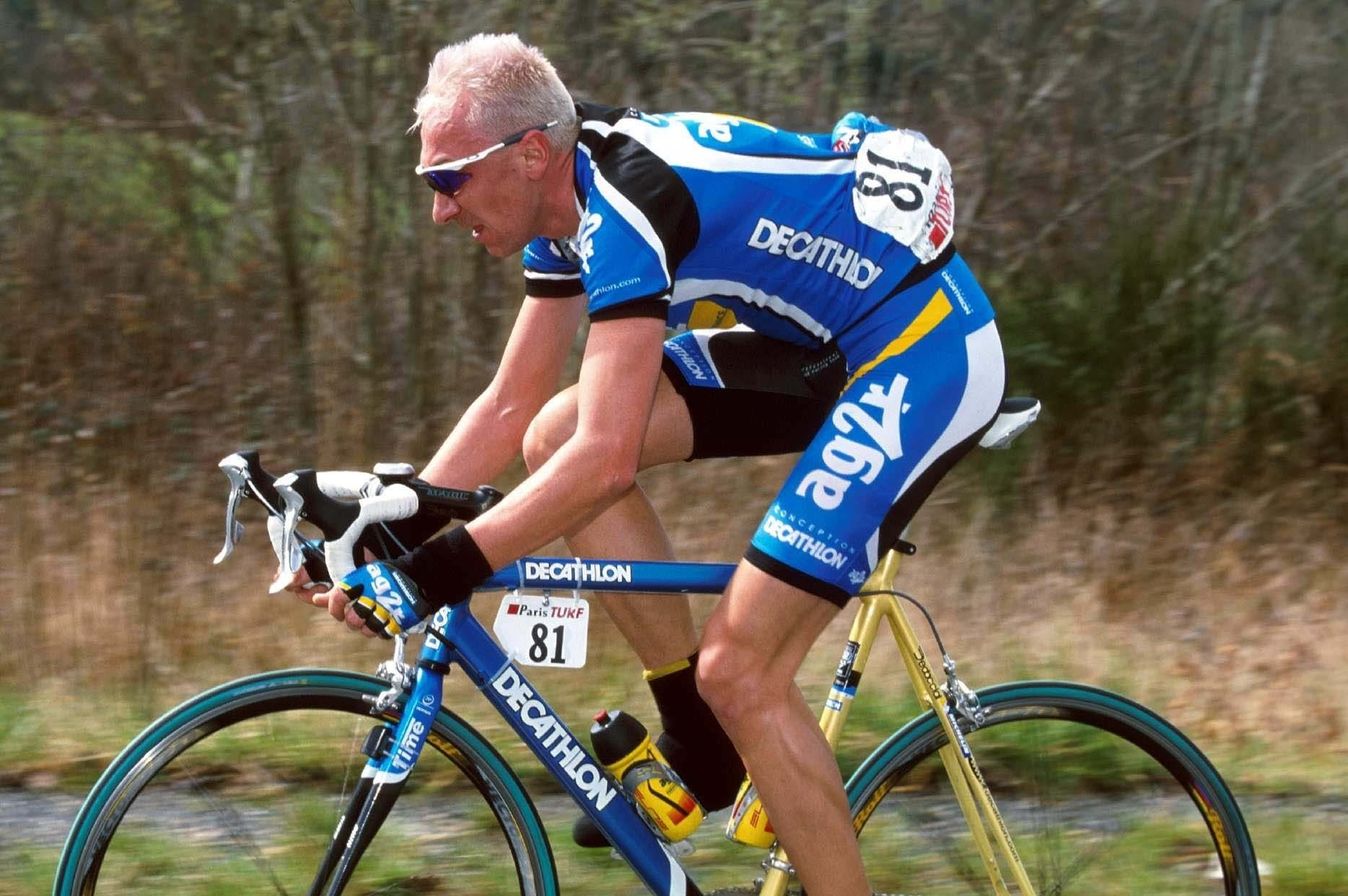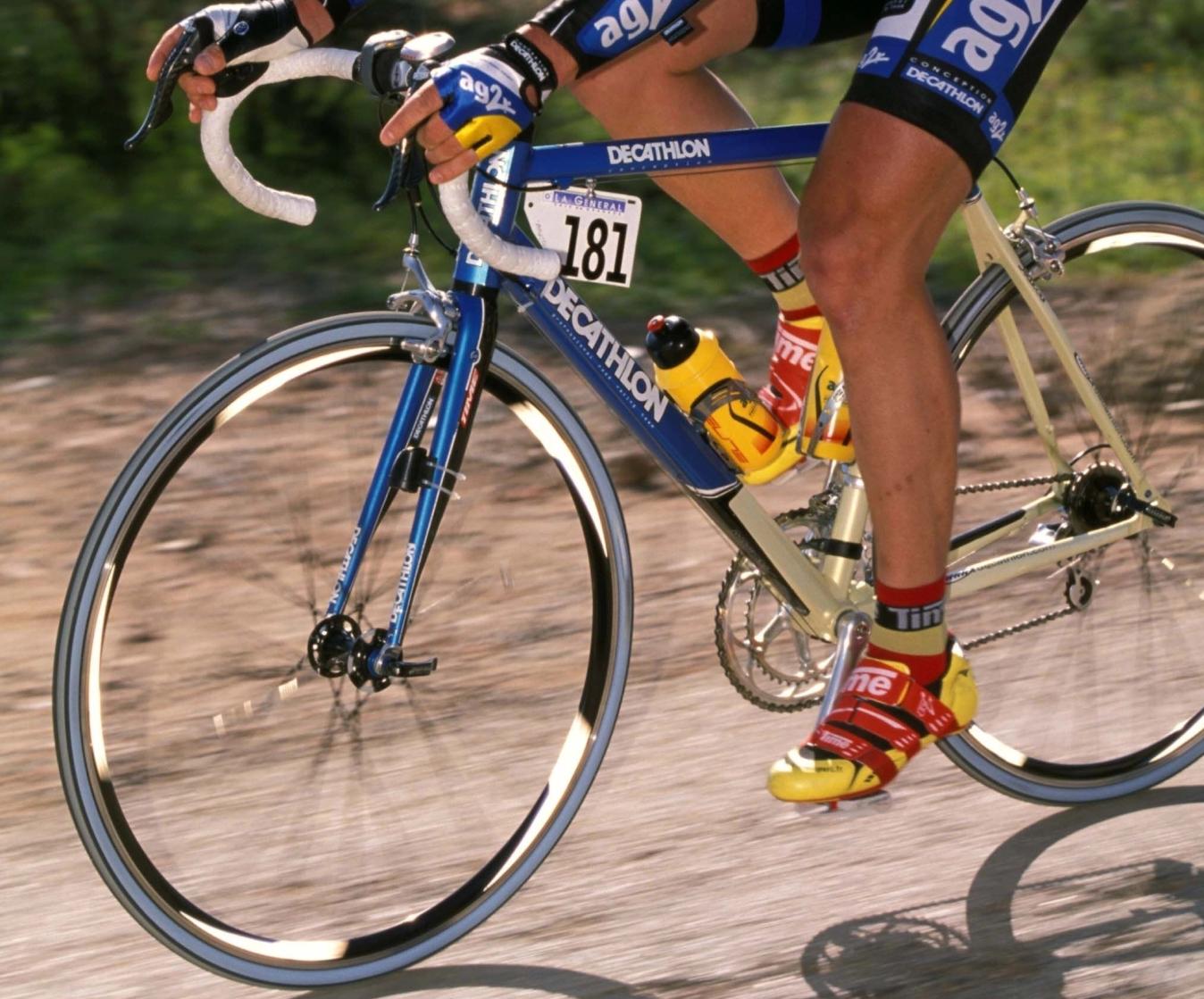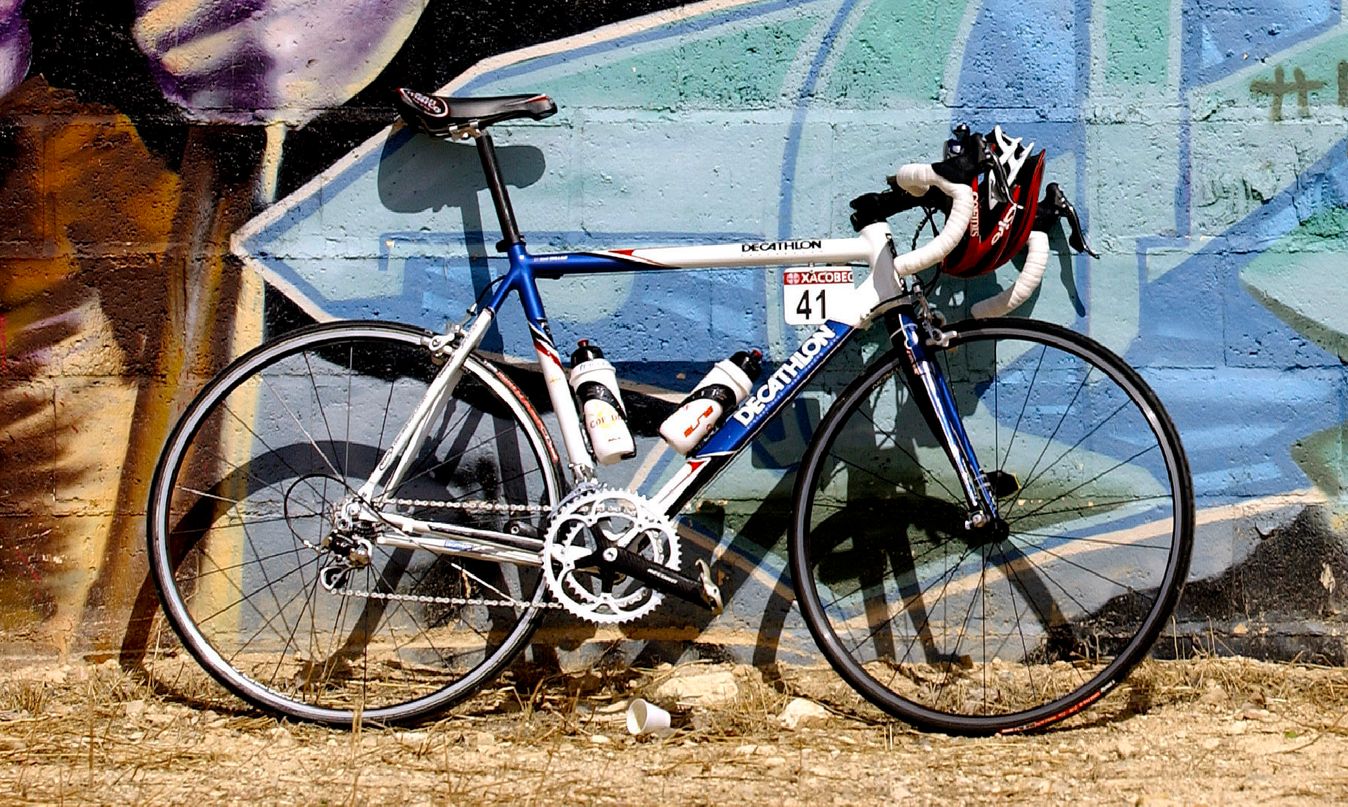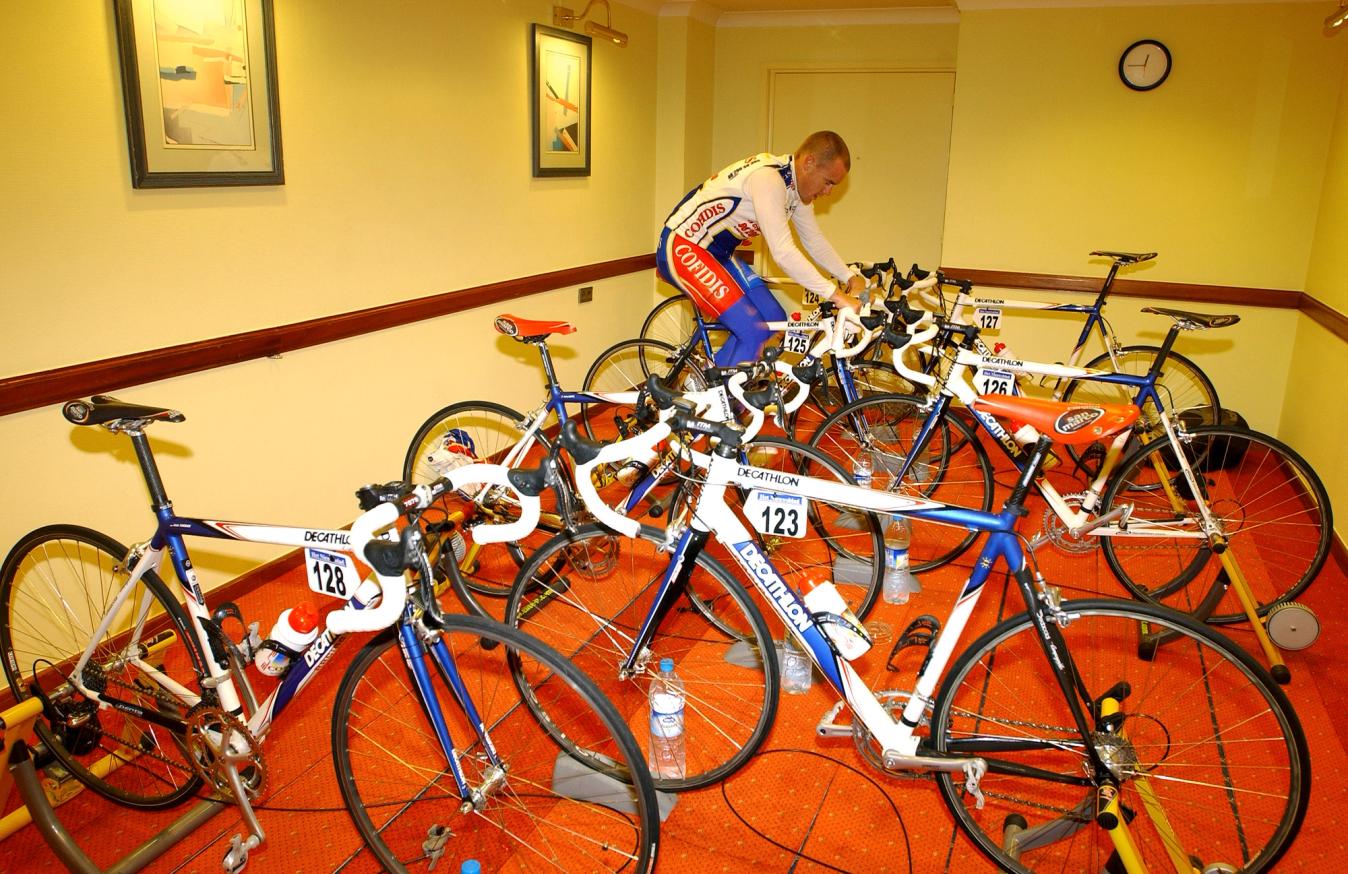Tech throwback: Remembering the Decathlon pro bikes of the 2000s
From the Replica Pro of the new millennium, through the Penta Pro and the carbon fibre Btwins, charting the retail giant's journey from 'supermarket bike brand' to pro peloton player
Patrick Fletcher
Deputy Editor
© Velo Collection (TDW) / Getty Images
Decathlon pro bikes through time
News of Decathlon’s entry into the pro peloton in 2024 generated a great deal of interest last week, as the sports retailer known for its budget-friendly bikes prepares to sponsor and supply a WorldTour team, Decathlon AG2R La Mondiale.
However, this is merely a return to the pro peloton, with Decathlon bikes having been ridden by two separate French teams in the early 2000s.
It was AG2R, in fact, who first used them in 2000, kicking off an eight-year spell in which Decathlon was a co-sponsor and later rolled out its Btwin brand. In 2003, AG2R were joined by French rivals Cofidis for two seasons, which saw a number of big wins across both squads.
The bikes of the noughties are a far cry from the new machines unveiled at the AG2R launch on Monday. Van Rysel, which was launched as Decathlon’s high-performance cycling brand in 2019, has recently developed a new range of race bikes, with Decathlon-AG2R set to use the RCR as the all-rounder road bike for all road stages, and the XCR time trial bike against the clock.
Read more: A closer look at the Van Rysel bikes Decathlon AG2R La Mondiale will ride in 2024
Wind the clock back nearly a quarter of a century, and the team saw in the new millennium aboard the Decathlon Replica Pro. This was an aluminium alloy bike, with 7003 series tubing from Dedaccia that had undergone Kinetic Energy Treatment. The frame was paired with a fork from Time that itself was a composite of carbon fibre and Vectran.

© Velo Collection (TDW) / Getty Images
Christophe Agnolutto on the 2001 Decathlon Replica Pro
The bikes came fitted with Shimano’s Dura-Ace 7700 groupset, with a 9-speed cassette that looks tiny by today’s standards. The wheels were the Vector Pros from Rolf, and the clincher tyres came from Michelin. The stem and bar were from Deda, and the saddle from Fizik.
According to what we can gather from the depths of the internet, the bike as sold in stores – with a few component differences to the team-issue bike – retailed for in the region of 20,000 French Francs, which is around £2,500 pounds (before two decades of inflation).
Decathlon also produced a time trial version with adapted tube profiling and an extended aero seat tube, but it wasn’t the sort of radically different design seen nowadays. In any case, there wasn’t much time to devote to a TT bike, given there wasn’t even much time to get a pro-level road bike off the ground.

© Velo Collection (TDW) / Getty Images
The TT version in action in 2001
The deal with AG2R was struck in the summer of 1999 and the cycling engineers were given barely three months to design a bike from scratch and bring 20 or so of them to a team training camp in November.
“Never has the Mark Twain phrase – ‘They did not know it was impossible so they did it’ – been so apt,” recalls one of the engineers, Andrew Lorenzi, in an old Decathlon brochure.
After three days in “the war room”, long conversations with Dedaccia and another frame partner Carlesso, they had a first draft. They also developed the Decathlon Ergonomie Système from a fellow engineer’s university thesis, and made use of computer-aided design to hone their concept before production.
And so they rocked up to the training camp and handed one of the bikes over to the team’s star Jan Kirsipuu, who’d reportedly been scathing of the 1999 Time bikes. The Estonian took it around the block, handed it back, and simply said "good bike".
“We’d done it,” Lorenzi recalls. “We went from supermarket bike brand to top-level technical partner… in the space of three months.”

© Velo Collection (TDW) / Getty Images
Belgian champion Ludovic Capelle on the Decathlon Replica Pro
The bike made an instant impact, as Giles Maignan won the season-opening Tour Down Under, and AG2R went on to win 20 races that year, 13 coming from Kirsipuu, plus a Tour de France stage win from Christophe Angolutto. The following year, that rose to 25, with Kirsipuu’s own return rising to 17.
The Penta Pro
In 2002, Decathlon updated its flagship bike, which became the Penta Pro. There was no significant change to the frame, which remained painted in blue and yellow, but the components received an overhaul.

© Velo Collection (TDW) / Getty Images
Jan Kirsipuu aboard the Decathlon Penta Pro in 2002
There was a switch from Shimano to Campagnolo and the Italian brand’s Record 10 groupset. More parts also came under Decathlon branding, notably the Penta wheels, which came from a collaboration with DT Swiss - a partnership that has been revived for 2024. Likewise, the bar and stem came in from ITM.
In 2003, Cofidis came along and hopped on the same bike, albeit with a different paint job that had more white and a touch of red. They also came with Campagnolo Record, and in addition used the Italian brand’s Bora wheelset, while the bar and stem was still ITM.

© Velo Collection (TDW) / Getty Images
David Millar's Decathlon Penta Pro for the 2003 Vuelta a España
The team won 24 races that year, the pick of the bunch being David Millar’s victory in the stage 19 time trial at the Tour de France, on board the Crono version of the bike.
However, It would appear Millar wasn’t overly enthused, as he rode a debranded black British Cycling bike en route to the world title a couple of months later – a title that was later stripped due to doping violations.

© Velo Collection (TDW) / Getty Images
David Millar riding a non-Decathlon at TT Worlds in 2003
The introduction of carbon
A major update came along in 2004, as the Penta Pro went part-carbon. The main triangle was still alloy but the seat stays and chain stays were made using carbon fibre for the first time for Decathlon.
There was also greater flexibility in frame production, with Decathlon making efforts to tailor frames to riders’ profiles, with Kirsipuu at Paris-Roubaix choosing a heavier, stronger version of the standard frame on which he’d win a stage of the Tour that year.

© Velo Collection (TDW) / Getty Images
Jan Kirsipuu at Paris-Roubaix in 2004
There was even an aesthetic change for that model, with more white on the frames for both AG2R and Cofidis, and prominent ‘Racing’ branding on the down tube.
Kirsipuu was one of two AG2R riders to triumph at the Tour, along with two from Cofidis, and so subsequent marketing for the Penta Pro touting this as a bike ‘designed to win four stages of the Tour de France’ as it was put on sale for €3,499.

© Velo Collection (TDW) / Getty Images
The 2004 edition Cofidis Decathlon Penta Pros
Btwin is born
The next major evolution in the Decathlon story came in 2006, as the brand burst onto the scene with a new name, a striking new design, and some very ostentatious carbon fibre.
This is when Btwin came along, which was launched as Decathlon’s standalone in-house bike brand. It has since been usurped by Van Rysel and, on the more budget end of the road bike market, Triban, but Btwin does live on, mainly in the form of kids bikes, while Decathlon’s cycling HQ in Lille, where the new Decathlon AG2R team was launched, is called the Btwin Village.
The first Btwin pro bike was the FC700, FC standing for full composite and the 700 for the T700-modulus carbon used. Decathlon and the team seemed keen to shout about joining the carbon party, with the frame first presented in a raw carbon weave that will either make your heart sing or make you wince.

© Velo Collection (TDW) / Getty Images
Samuel Dumoulin aboard the Btwin FC700 in 2006
They were making a statement with the frame design and shaping too. It was as if Decathlon were desperate to shake off their tag as ‘supermarket bike brand’ and twist it into something more cutting-edge. Gone were the modest rounded alloy tubes, replaced with hard-edges and a futuristic seatpost-toptube-seatstay junction.
This was the standout feature, with the toptube flowing into the stays and up into an extended almost-integrated seatpost in a bid to add support and a touch of compliance.

© Sprint Cycling Agency
A closer look at the FC700 frame
The claimed weight of the frame was 1.07kg in a size 55. The fork was still made by Time and the stem by ITM, but the Penta wheels were soon retired and switched out for Campagnolo, whose Record groups had steadily gained flashes of carbon of its own.
“From the blank sheet to finished product, having gone through all the testing, took us six months,” said Lorenzi, indicating once again that the switch to carbon was a race against time.
The FC900

© Velo Collection (TDW) / Getty Images
French champ Christophe Moreau aboard the FC900 at the 2007 Tour de France
It didn’t take long for a new version of the bike to appear, as 2007 saw the gradual introduction of the FC900, which used a higher-modulus carbon that was lighter and stiffer.
There was no significant change in the frame design but there was a new fork, with a higher taper, which was made without the help of Time and brought in-house with Btwin FC branding. The carbon weave was also dialled back in favour of splashes of white paint, while Deda were welcomed back in for the bars and stem.
During these Btwin years, the team rode time trials on what looked much more like the old Penta line.

© Velo Collection (TDW) / Getty Images
Christophe Moreau rides a Btwin bike in the Dauphiné time trial
The AG2R team had a steady stream of victories on their Btwin bikes, with Simon Gerrans getting his career off the ground in 2006 and Christophe Moreau winning the Dauphiné and French road race title in 2007.
However, that was to be the end of the road for Decathlon’s involvement in the pro peloton, or rather, the start of a 16-year pause. They did supply clothing under the Btwin brand to teams including FDJ, but as far as getting their performance road bike range off the ground, it was job done.
“The technical credibility the partnership brought was a real sales-booster,” said Lorenzi. “In fact, we didn’t have to sell them; they flew off the shelves all by themselves.”
Having identified cycling as a cornerstone of their global growth strategy, Decathlon will be hoping for more of the same in 2024 and beyond.










